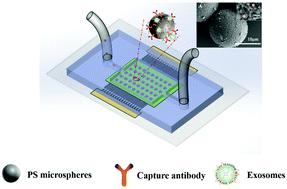Our official English website, www.x-mol.net, welcomes your
feedback! (Note: you will need to create a separate account there.)
Microsphere mediated exosome isolation and ultra-sensitive detection on a dielectrophoresis integrated microfluidic device
Analyst ( IF 3.6 ) Pub Date : 2021-09-08 , DOI: 10.1039/d1an01061a Wenjie Zhao 1, 2 , Lingqian Zhang 1 , Yifei Ye 1, 2 , Yuang Li 1, 2 , Xiaofeng Luan 1 , Jinlong Liu 1 , Jie Cheng 1, 2 , Yang Zhao 1 , Mingxiao Li 1 , Chengjun Huang 1, 2
Analyst ( IF 3.6 ) Pub Date : 2021-09-08 , DOI: 10.1039/d1an01061a Wenjie Zhao 1, 2 , Lingqian Zhang 1 , Yifei Ye 1, 2 , Yuang Li 1, 2 , Xiaofeng Luan 1 , Jinlong Liu 1 , Jie Cheng 1, 2 , Yang Zhao 1 , Mingxiao Li 1 , Chengjun Huang 1, 2
Affiliation

|
Tumor-derived exosomes have been recognized as potential biomarkers for cancer diagnosis because they are actively involved in cancer progression and metastasis. However, progress in practical exosome analysis is still slow due to the limitation in exosome isolation and detection. The development of microfluidic devices has provided a promising analytical platform compared with traditional methods. In this study, we develop an exosome isolation and detection method based on a microfluidic device (ExoDEP-chip), which realized microsphere mediated dielectrophoretic isolation and immunoaffinity detection. Exosomes were firstly isolated by binding to antibodies pre-immobilized on the polystyrene (PS) microsphere surface and were further detected using fluorescently labeled antibodies by fluorescence microscopy. Single microspheres were then trapped into single microwells under the DEP force in the ExoDEP-chip. A wide range from 1.4 × 103 to 1.4 × 108 exosomes per mL with a detection limit of 193 exosomes per mL was obtained. Through monitoring five proteins (CD81, CEA, EpCAM, CD147, and AFP) of exosomes from three different cell lines (A549, HEK293, and HepG2), a significant difference in marker expression levels was observed in different cell lines. Therefore, this method has good prospects in exosome-based tumor marker detection and cancer diagnosis.
中文翻译:

在介电泳集成微流体装置上微球介导的外泌体分离和超灵敏检测
肿瘤来源的外泌体已被公认为癌症诊断的潜在生物标志物,因为它们积极参与癌症进展和转移。然而,由于外泌体分离和检测的局限性,实际外泌体分析的进展仍然缓慢。与传统方法相比,微流体装置的发展提供了一个有前途的分析平台。在本研究中,我们开发了一种基于微流控装置(ExoDEP-chip)的外泌体分离和检测方法,实现了微球介导的介电泳分离和免疫亲和检测。首先通过与预先固定在聚苯乙烯 (PS) 微球表面上的抗体结合来分离外泌体,并通过荧光显微镜使用荧光标记的抗体进一步检测。然后在 ExoDEP 芯片中的 DEP 力下,单个微球被困在单个微孔中。宽范围从 1.4 × 10获得了每毫升3至 1.4 × 10 8 个外泌体,检测限为每毫升 193 个外泌体。通过监测来自三种不同细胞系(A549、HEK293 和 HepG2)的外泌体的五种蛋白质(CD81、CEA、EpCAM、CD147 和 AFP),在不同细胞系中观察到标记物表达水平的显着差异。因此,该方法在基于外泌体的肿瘤标志物检测和癌症诊断方面具有良好的前景。
更新日期:2021-09-08
中文翻译:

在介电泳集成微流体装置上微球介导的外泌体分离和超灵敏检测
肿瘤来源的外泌体已被公认为癌症诊断的潜在生物标志物,因为它们积极参与癌症进展和转移。然而,由于外泌体分离和检测的局限性,实际外泌体分析的进展仍然缓慢。与传统方法相比,微流体装置的发展提供了一个有前途的分析平台。在本研究中,我们开发了一种基于微流控装置(ExoDEP-chip)的外泌体分离和检测方法,实现了微球介导的介电泳分离和免疫亲和检测。首先通过与预先固定在聚苯乙烯 (PS) 微球表面上的抗体结合来分离外泌体,并通过荧光显微镜使用荧光标记的抗体进一步检测。然后在 ExoDEP 芯片中的 DEP 力下,单个微球被困在单个微孔中。宽范围从 1.4 × 10获得了每毫升3至 1.4 × 10 8 个外泌体,检测限为每毫升 193 个外泌体。通过监测来自三种不同细胞系(A549、HEK293 和 HepG2)的外泌体的五种蛋白质(CD81、CEA、EpCAM、CD147 和 AFP),在不同细胞系中观察到标记物表达水平的显着差异。因此,该方法在基于外泌体的肿瘤标志物检测和癌症诊断方面具有良好的前景。











































 京公网安备 11010802027423号
京公网安备 11010802027423号